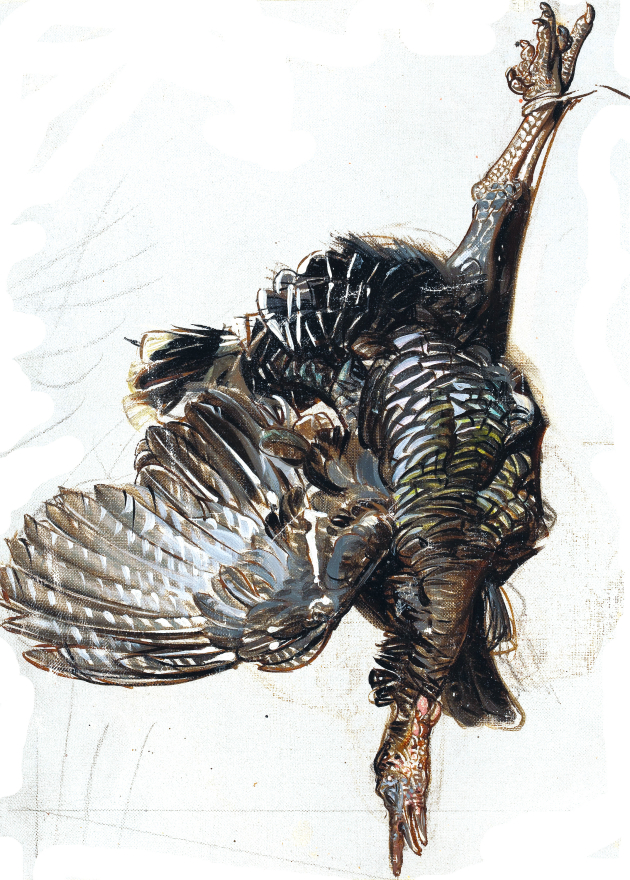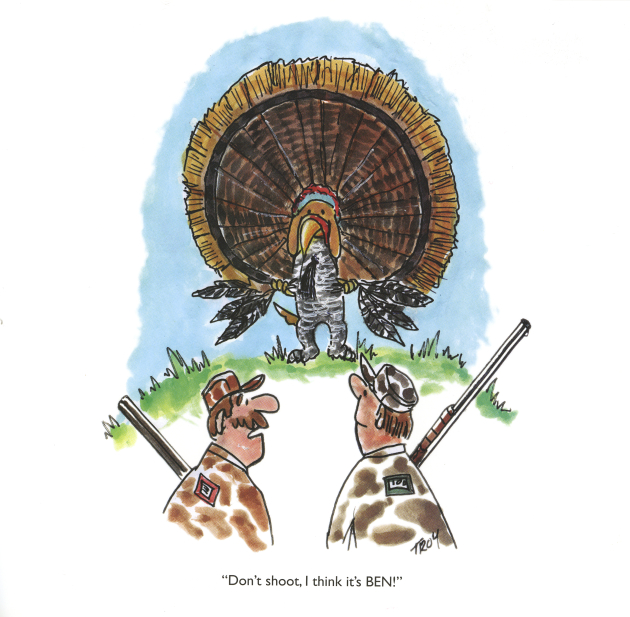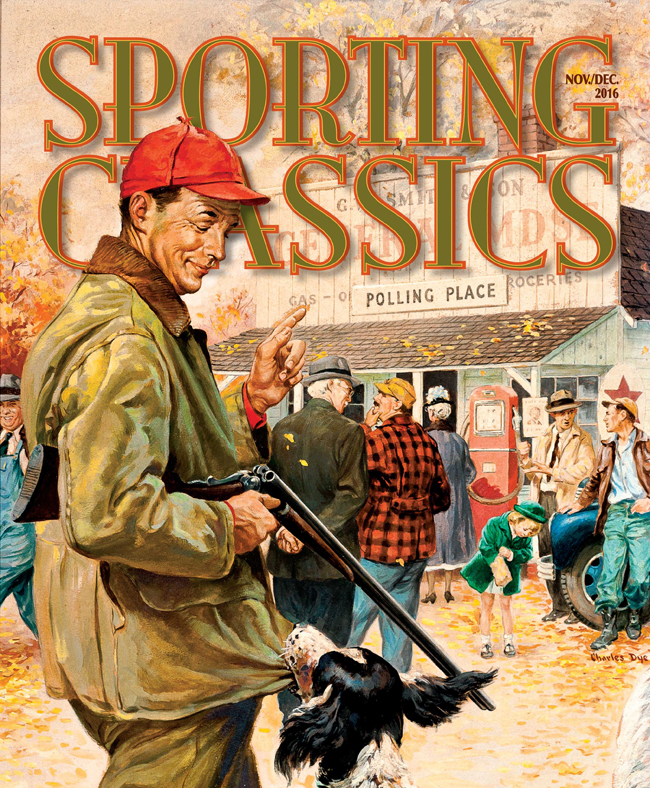Note: “How I Lost My Thanksgiving Turkey” originally appeared in the November 1891 issue of Outing magazine; it also appeared in Sporting Classics’ latest issue. Not a subscriber? Sign up now!
The turkey is a wondrous, toothsome morsel, whether it be a choice bird from the fattening pen or one of those kings of the feathered race, a grand wild fellow, slain perhaps after a deal of toil and trouble in his native haunt—some Southern woodland, Western scrub, or high-country meadow. But such birds as these are by no means easily procured, and only a favored few of the millions of feasters on Thanksgiving Day will sink tooth into genuine wild turkey meat. The price paid by the epicure for his wild bird would doubtless purchase provisions enough to feast a family of the bread-winning class on excellent fare for an entire week, so the toilers must be content with a less aristocratic fowl than Meleagris gallopavo.
Year by year the birds are steadily decreasing in number, and the day is not far distant when the turkey will exist no longer in the wild state, save in a few favored portions of the South and Southwest. Easily trapped and always valuable, either for the market or for home consumption, it is hardly surprising that the birds have been eagerly sought and remorselessly slain wherever found, and were it not for their keen sight and swift and enduring running powers, they would long ago have been exterminated in certain accessible forests, where a few yet find a home.
While the turkey is one of the easiest birds to trap, he is no fool to follow with rifle or shotgun in his forest ranges. Wild and shy to a degree, keen-sighted, quick-eared, swift of foot, and strong of wing when needs be, he is also sharply suspicious of a man on foot, and quite as difficult to “still-hunt” successfully as a deer.
Generally ranging in heavy forest, tangled scrub, and within easy reach of some other baffling cover, no sooner does he suspect danger than his long legs bear him swiftly to the densest growth he can find, through which a man may track him for hours without either obtaining a shot or forcing him to take wing. Frequently the bird will not even be seen.
The principles of good sportsmanship apply to taking the wild turkey by several methods. One of these is shooting the birds when roosting in tall timber at night. All that is necessary is first to locate the roost, then steal upon the unsuspecting game and shoot as many as possible before the turkeys realize what is going on and leave the unhealthy neighborhood.
A second method is calling, or “yelping.” Using a bone from a turkey’s wing as a caller, the sportsman sucks air through the bone to imitate the “yelp” of a gobbler. An ordinary clay pipe also makes an excellent caller. This method may be followed with deadly effect either after a flock has been scattered or, as done in the South, while the gobblers are strutting, in which case a good imitation of the cry of a lovelorn hen will lure the male to his destruction.
Still another method, the most dashing and exciting sport of all, is coursing the birds with greyhounds. This, of course, demands an open country, and is, I believe, only attempted on the plains of the far South and Southwest.
For this, the sportsman must be a good horseman and be well mounted, as the going is fast and free and the ground covered frequently dangerous. When turkeys are found feeding in the open, the dogs are slipped, and when the birds take wing, horse and hounds follow the selected victim as fast as they can lay foot to the ground.
The turkey flies straight, and though its first flight may be a half-mile or more, it has not time to recover from the unusual exertion ere the fleet dogs again compel it to take wing. It may rise two or three times, but its strength is soon spent, and unless it can reach heavy cover, the dogs will pull it down. The horseman, meanwhile, follows the chase as best he can.
Yet another method, and a thoroughly sportsmanlike one, is tracking, or still-hunting. The best time for this is immediately after a light fall of snow, when all sign is fresh and the contest simply becomes a fair test of hunter’s craft against cunning and endurance.
The still-hunter will surely earn his bird, no matter whether he carries a rifle and kills his game at long range, or with a shotgun and kills it flying after he has fairly tramped it to a standstill, forced it from sheer weariness to squat and hide, and then flushed it from cover by his close approach.
Tracking turkeys in the kind of ground they usually favor is emphatically hard work, and the tracker will be led, perhaps, for mile after mile through just the sort of cover that tempts one to halt and “talk the bark off a tree” now and then. I have many times followed turkeys—sometimes on the tracks, sometimes by guesswork—for an entire day and never once had a chance at a bird.
One fall, that now has many leaves upon its grave, I decided to take a run on the Canada Southern into Essex Woods and try for a good gobbler, though a plump hen would doubtless have also received attention. It had rained hard for several days, then the cold came, and with it a slight fall of snow, though hardly sufficient for good tracking.
It was an extremely sharp, clear, bracing morning when I left a comfortable farmhouse some miles west of Essex Centre, and with Winchester on shoulder started for the great, silent stretch of woods which extended for miles in every direction. I knew that turkey were in these woods and was fully resolved to have one before night, but no sooner was the timber fairly entered than the unpleasant fact became painfully apparent that it wasn’t a good day for hunting turkey.

“Study of a Turkey Leg,” by Joseph Christian Leyendecker (1874-1951).
Every hollow between the thick-standing oaks, maples, and elms had been filled to o’erflowing by the rains, and now every pool was covered with an inch-thick coat of ice—just thick enough not to bear 180 pounds. Every twig and frozen leaf under foot, moreover, was crushed like glass, and under such conditions I was about as likely to get within shot of a turkey as I was to tree a Bengal tiger up one of the big elms. There was nothing for it but to acknowledge a balk, and I retreated to the railroad, the track being about the only place where dry walking was possible. After infinite difficulty, aided by a couple of rails from the snake fence, I managed to safely cross the deep ditch between the woods and the track, and so reached safe footing.
It was an exasperating situation. Straight as a rule, east and west, stretched the narrow bed with its two shining rails. On either side were broad ditches containing water, perhaps five feet deep, coated with treacherous ice, and I thus had a promenade more than 100 miles long but only about 15 feet wide. A tempting shooting ground, truly! A fellow might get “rail birds” on it or shoot off a few ties to fill in time, but it was not very exhilarating, I confess. There was nothing to do until the evening train came along to take me home again.
Nothing but a heavy frost, followed by snow, would make still-hunting possible, and there were no indications of snow. For want of something better to do, I strolled a couple of miles along the track, and by so doing made a discovery that changed the aspect of affairs considerably.
A car laden with shelled corn must have passed some days before and had a hole in it, for a long stream of yellow grain extended for some 300 yards besides the rails. Near one end of the corn was a culvert crossing the track, through which, under ordinary conditions, cattle could readily pass. But it was now filled to within a couple of feet of the top with water.
Everywhere within a short distance of this culvert I found the sign of wild turkeys, and it was an easy task to read the possibilities.
The birds had discovered the trail of grain and had been feeding on it for two or three days at least. The rains had drowned out their feeding grounds in the woods, and they would be sure to return to the corn day after day until the last grain was eaten. It was simply a question of close hiding, more or less of the long agony of hope deferred, and then a turkey would be mine! I fairly grinned over that layout.
But where to hide? Not an available point offered; the track was as bare as a rifle barrel, and the roadbed was elevated so much above the level of the woods that it could not be properly commanded unless I climbed a tree, which would be altogether unsuitable.
The culvert!
Yes, the culvert; but the ice will barely hold, thought I. However, a look at it would do no harm. I carefully tested it and found that, owing to its narrowness and the grip on the timber walls afforded the ice, it would just bear me.
Happy thought: a board off yon gate, broken in two and cushioned with a layer of dry grass, would make a comfortable resting place and allow me to spread my weight across the ice sufficiently to make all safe. The board was soon secured, placed in two halves on the ice, and padded with handfuls of withered herbage. I was ready for business.
Sitting upon my boards, I could just comfortably raise my eyes above the track, and if I got upon my knees, the edge of the culvert afforded a dead rest for my elbow. I felt I couldn’t miss a turkey at 150 yards if I tried. It was superb, and I grinned some more. This was just the luckiest, laziest, dead-certain turkey shoot on record.
For some time I sat there, closely watching the track and the woods upon either side. It was tedious, cold work, and in due time I grew weary and cramped from the confined position and varied things by creeping out of my shelter and having a bit of a dance to stir sluggish blood. Just as I thought of again going to cover, a black object moved in the woods perhaps 200 yards away. No need for a second glance; it could only be a turkey; and as speedily as possible I crawled back into the culvert, and with my head close to the rail, waited for further developments.
Moments dragged slowly past, and at last one bird appeared on the track a good 500 yards off, and was presently followed by another, and another, and yet others until nine stately fowl were in plain view. They soon turned in my direction and moved slowly forward.
It was now a “regular cinch,” and I hugged my head closer into the rail and glared down the track at those turkeys with a burning intentness that melted what little snow there was near my face. They were coming—they were bound to feed right up to my stand if I chose to let ’em.
I would plunk the big gobbler, which I could distinguish from where I lay, and then take chances for another, run or fly. No, I wouldn’t, either. I would be silent and wary as a lynx and let them feed good and close, and wait for the big fellow and another to get in line and straighten out a brace of them at the one shot.
They came steadily on. They were now only about 400 yards away, and advancing in a long line, Indian file. Nearer and nearer they came, and I changed my purpose. Two in line were not enough for such an opportunity. I would draw a dead bead on the big fellow and hold on him till three birds were in range. Yes, that would be better.
Still they advanced, and only 300 yards separated them from their doom. Now they quickened their movements and advanced rapidly for some distance. They had reached the trail of corn and were crowded close over the first scattered grains. Once again my resolution wavered. Hang it all! It was just as easy to get four in line—a ball at short range would stiffen four of them easy enough. I must have four.
Step by step, yard by yard, they came on, ever drawing nearer and nearer to the certain death that waited to claim its four. Every once in a while they would all bunch together, and as they did this at a range of about 200 yards my modesty wavered again.
Could it not be possible to drive a ball through five of them in line? Such a record—such a shot to describe to the boys! Five grand wild turkeys at one lick!
I was just fairly entertaining the five notion when an ominous click sounded along the rails, that mysterious click which announces the coming of a train. Click–tuck–click! There was no mistake. It must be a freight, for no express was due at that hour.
Click—tuck-lick—click! The mysterious message had reached the turkeys’ ears, too, and they lifted their heads on high and stood motionless. I breathed a few stanzas of vulgarized adjectives at the infernal change of luck and considered what I should do. I might try a long shot, but it would be doubtful. If I showed myself, goodbye to those turkeys.
My mind was almost made up to shoot at once, for the rails were now clicking merrily, when, like a saving clause, the thought occurred to me that they heard trains passing many times every day, and would probably merely retreat into the woods for a short distance and return when all became still. They had certainly been disturbed in this fashion more than once before.
These reflections were rather comforting, and I resolved to just lay low where I was and let the train thunder above my head. I was perfectly safe and could get my five birds just as well as not when they came back. I took a peep eastward, and there, sure enough, was my train coming along at a great rate. Looking again in the direction of the turkeys, I saw the last two or three trot slowly into cover. They undoubtedly were not seriously alarmed and would most likely resume feeding in a half-hour.
There I lay, close as possible, and in a moment the train thundered overhead with a tremendous clatter. Though I knew I was perfectly secure, I fairly shuddered as the first couple of pairs of wheels passed so close to my head.
Heavens! What a jar and row it made! Would it never draw its frightful length across that culvert? At last, when I was almost deafened, a blessed pause in the uproar brought relief. A hollow plunk-plunk of the last pair of wheels announced the complete passage of the conductor’s red van, and I made a move to rise.
There was a faint, squeaking, grinding noise, a squirt of ice-cold water, then a frightful crash and splash, and I gave an involuntary imitation of a young man falling through a glass skylight and fetching up in a well. The vibration of the train had loosened the ice from the walls of the culvert, and the whole business broke into fragments, and I was in it!
I didn’t wait to touch bottom, but pawed and sputtered and floundered round with the bits of board and the roots and the grass and the ice, and clambered out just as quick as the Lord would allow. Then I swore at the train, and at the turkeys and the culvert and the ice, and the water and the smart Aleck who planned the ambush. Then, in spite of chattering teeth and trembling limbs, I laughed—I had to laugh.
But the worst of it was that I had to go in again . . . clean underwater for a horrible quarter-minute to recover the rifle by locating it with my foot, for no consideration would have induced me to leave it there. Then I clambered out once more and, groaning and shivering and shedding water every jump, ran and walked and staggered the best way I could to the farmhouse, where I had a hot drink and a sleep in thick blankets while my clothes were thoroughly dried. That was finally accomplished late in the afternoon, but whether or not it’s possible to drive a ball through five turkeys in line, I guess I’ll never know.
Subscribe to Sporting Classics today to get great sporting stories like this sent directly to your home eight times a year. Already a subscriber? Give the gift of literature this Christmas with a gift subscription!


